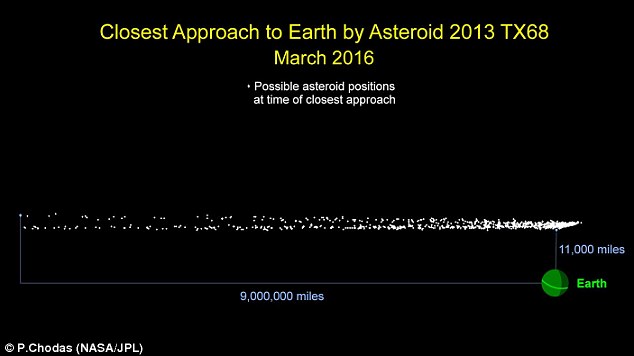

A 100ft-wide asteroid, first spotted when it flew by Earth two years ago, is set to make its return – and this time it could get incredibly close.
The whale-sized space rock may skim past Earth at just 11,000 miles (17,000 km), which is around 21 times closer to Earth than the moon.
But Nasa admits this estimate may be widely inaccurate, and the asteroid may also pass Earth as far out as 9 million miles (14 million km).
In both scenarios, the space agency says the asteroid, dubbed 2013 TX68, poses no threat to Earth.

A small asteroid, first spotted when it flew by Earth two years ago, is set to make its return – and this time it will get even closer. This graphic indicates the possible locations asteroid 2013 TX68 will be in at the time of its closest approach to Earth during its safe fly-by of our planet on March 5
'The variation in possible closest approach distances is due to the wide range of possible trajectories for this object, since it was tracked for only a short time after discovery,' Nasa explained.
Scientists have identified an extremely remote chance that this small asteroid could impact on September 28, 2017, with odds of no more than 1-in-250-million.
Flybys in 2046 and 2097 have an even lower probability of impact.
'The possibilities of collision on any of the three future flyby dates are far too small to be of any real concern,' said Paul Chodas, manager of CNEOS.
'I fully expect any future observations to reduce the probability even more.'

Scientists at Nasa's Center for NEO Studies (CNEOS) in California, say 'there is no possibility that this object could impact Earth during the flyby next month.' But they have identified an extremely remote chance that this small asteroid (stock image pictured) could impact on Septmeber 28, 2017, with odds of 1-in-250-million
Asteroid 2013 TX68 is estimated to be about 100ft (30 meters) in diameter.
By comparison, the asteroid that broke up in the atmosphere over Chelyabinsk, Russia, three years ago was approximately 65 feet (20 meters) wide.
If an asteroid the size of 2013 TX68 were to enter Earth's atmosphere, it would likely produce an air burst with about twice the energy of the Chelyabinsk event.
The asteroid was discovered by the Nasa-funded Catalina Sky Survey on October 6, 2013, as it approached Earth on the night-time side.
After three days of tracking, the asteroid passed into the daytime sky and could no longer be seen.
Because it was not tracked for very long, scientists cannot predict its precise orbit around the sun, but they do know that it cannot impact Earth during its flyby next month.
'This asteroid's orbit is quite uncertain, and it will be hard to predict where to look for it,' said Chodas.
'There is a chance that the asteroid will be picked up by our asteroid search telescopes when it safely flies past us next month, providing us with data to more precisely define its orbit around the sun.'
In September, Paul Chodas, manager of Nasa's Near-Earth Object office at the Jet Propulsion Laboratory in Pasadena, said: 'There is no existing evidence that an asteroid or any other celestial object is on a trajectory that will impact Earth.
'In fact, not a single one of the known objects has any credible chance of hitting our planet over the next century.
Nasa tracks around 12,992 near-Earth objects which have been discovered orbiting within our solar system close to our own orbit.
It estimates around 1,607 are classified as Potentially Hazardous Asteroids.
 Have you ever taken these beautiful subways in China?
Have you ever taken these beautiful subways in China? Chinese beauties, foreign models meet in Chengdu
Chinese beauties, foreign models meet in Chengdu Awesome! Aerial pictures taken on J-11 fighter
Awesome! Aerial pictures taken on J-11 fighter A foreign girl explains what China should be proud of
A foreign girl explains what China should be proud of Chinese navy's air-cushioned landing craft in pictures
Chinese navy's air-cushioned landing craft in pictures Chinese pole dancing master opens class in Tianjin
Chinese pole dancing master opens class in Tianjin Splendid Sichuan after snow
Splendid Sichuan after snow College girl of Vancouver crowned Miss Chinese Int'l 2016
College girl of Vancouver crowned Miss Chinese Int'l 2016 Pentagonal Mart becomes the largest vacant building in Shanghai
Pentagonal Mart becomes the largest vacant building in Shanghai Top 20 hottest women in the world in 2014
Top 20 hottest women in the world in 2014 Top 10 hardest languages to learn
Top 10 hardest languages to learn 10 Chinese female stars with most beautiful faces
10 Chinese female stars with most beautiful faces China’s Top 10 Unique Bridges, Highways and Roads
China’s Top 10 Unique Bridges, Highways and Roads Buying nianhuo!
Buying nianhuo! What Chinese try to sneak on flights (and how)
What Chinese try to sneak on flights (and how) Northeast authorities vow they will work to eradicate GM grains
Northeast authorities vow they will work to eradicate GM grains China’s richest village manages to transition away from old industries
China’s richest village manages to transition away from old industriesDay|Week